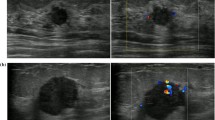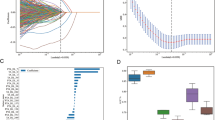Abstract
Breast cancer is the leading killer of Chinese women. Immunohistochemistry index has great significance in the treatment strategy selection and prognosis analysis for breast cancer patients. Currently, histopathological examination of the tumor tissue through surgical biopsy is the gold standard to determine immunohistochemistry index. However, this examination is invasive and commonly causes discomfort in patients. There has been a lack of noninvasive method capable of predicting immunohistochemistry index for breast cancer patients. This paper proposes a machine learning method to predict the immunohistochemical index of breast cancer patients by using noninvasive contrast-enhanced ultrasound. A total of 119 breast cancer patients were included in this retrospective study. Each patient implemented the pathological examination of immunohistochemical expression and underwent contrast-enhanced ultrasound imaging of breast tumor. The multi-dimension features including 266 three-dimension features and 837 two-dimension dynamic features were extracted from the contrast-enhanced ultrasound sequences. Using the machine learning prediction method, 21 selected multi-dimension features were integrated to generate a model for predicting the immunohistochemistry index noninvasively. The immunohistochemical index of human epidermal growth factor receptor-2 (HER2) was predicted based on multi-dimension features in contrast-enhanced ultrasound sequence with the sensitivity of 71%, and the specificity of 79% in the testing cohort. Therefore, the noninvasive contrast-enhanced ultrasound can be used to predict the immunohistochemical index. To our best knowledge, no studies have been reported about predicting immunohistochemical index by using contrast-enhanced ultrasound sequences for breast cancer patients. Our proposed method is noninvasive and can predict immunohistochemical index by using contrast-enhanced ultrasound in several minutes, instead of relying totally on the invasive and biopsy-based histopathological examination.

Immunohistochemical index prediction of breast tumor based on multi-dimension features in contrast-enhanced ultrasound.





Similar content being viewed by others
Abbreviations
- HER2:
-
Human epidermal growth factor receptor-2
- CEUS:
-
Contrast-enhanced ultrasound
- ROI:
-
Region of interest
- 3D:
-
Three-dimension
- 2D:
-
Two-dimension
- AUC:
-
Area under the receiver operating characteristic curve
- ER:
-
Estrogen receptor
References
Siegel R, Jemal A (2013) Breast cancer facts and figures 2013-2014. In: American Cancer Society. 1(3): 1–38
Davis BW, Gelber RD, Goldhirsch A et al (1986) Prognostic significance of tumor grade in clinical trials of adjuvant therapy for breast cancer with axillary lymph node metastasis. Cancer 16(12):1212–1218
Gonzalezangulo AM, Litton JK, Broglio KR et al (2009) High risk of recurrence for patients with breast cancer who have human epidermal growth factor receptor 2-positive, node-negative tumors 1 cm or smaller. J Clin Oncol 27(34):5700–5706
Rakha EA, Ellis IO (2007) An overview of assessment of prognostic and predictive factors in breast cancer needle core biopsy specimens. J Clin Pathol 60:1300–1306
Denley H, Pinder SE, Elston CW, Lee AH, Ellis IO (2001) Preoperative assessment of prognostic factors in breast cancer. J Clin Pathol 54:20–24
Valero V, Buzdar AU, Hortobagyi GN (1996) Locally advanced breast cancer. Oncologist 1:8–17
Umemura S, Takekoshi S, Suzuki Y, Saitoh Y, Tokuda Y, Osamura RY (2005) Estrogen receptor-negative and human epidermal growth factor receptor 2-negative breast cancer tissue have the highest Ki-67 labeling index and EGFR expression: gene amplification does not contribute to EGFR expression.[J]. Oncol Rep 14(2):337–343
Cortes J, Baselga J (2009) How to treat hormone receptor-positive, human epidermal growth factor receptor 2-amplified breast cancer. J Clin Oncol 27(33):5492–5494
Dawood S, Kristine Broglio MS, Yun GM et al (2010) Prognostic significance of HER-2 status in women with inflammatory breast cancer. Cancer 112(9):1905–1911
Tokunaga E, Oki E, Nishida K, Koga T, Egashira A, Morita M, Kakeji Y, Maehara Y (2006) Trastuzumab and breast cancer: developments and current status. Int J Clin Oncol 11:199–208
Ross JS, Fletcher JA, Bloom KJ, Linette GP, Stec J, SymmansWF et al (2004) Targeted therapy in breast cancer: the HER-2/ neu gene and protein. Mol Cell Proteomics 3:379–398
Nielsen DL, Andersson M, Kamby C (2008) HER2-targeted therapy in breast cancer. Monoclonal antibodies and tyrosine kinase inhibitors. Cancer Treat Rev 35:121–136
Nguyen PL, Taghian AG, Katz MS, Niemierko A, Abi Raad RF, Boon WL, Bellon JR, Wong JS, Smith BL, Harris JR (2008) Breast cancer subtype approximated by estrogen receptor, progesterone receptor, and HER-2 is associated with local and distant recurrence after breast-conserving therapy. J Clin Oncol 26:2373–2378
Murphy CG, Modi S (2009) HER2 breast cancer therapies: a review. Biologics Targets Ther 2009(default):289
Hicks DG, Kulkarni S (2008) HER2+ breast cancer: review of biologic relevance and optimal use of diagnostic tools. Am J Clin Pathol 129(2):263–273
Rocque G, Onitilo A, Engel J et al (2012) Adjuvant therapy for HER2+ breast cancer: practice, perception, and toxicity. Breast Cancer Res Treat 131(2):713–721
Guerra I, Algorta J, De Otazu RD et al (2003) Immunohistochemical prognostic index for breast cancer in young women. Mol Pathol 56(6):323–327
Klauber-DeMore N (2006) Tumor biology of breast cancer in young women. Breast Dis 23(1):9–15
Burcombe RJ, Makris A, Richman PI, Daley FM, Noble S, Pittam M, Wright D, Allen SA, Dove J, Wilson GD (2005) Evaluation of ER, PgR, HER-2 and Ki-67 as predictors of response to neoadjuvant anthracycline chemotherapy for operable breast cancer. Br J Cancer 92(1):147–155
Balleyguier C, Opolon P, Mathieu MC, Athanasiou A, Garbay JR, Delaloge S, Dromain C (2009) New potential and applications of contrast-enhanced ultrasound of the breast: own investigations and review of the literature. Eur J Radiol 69(1):14–23
Zhang Y, Jiang Q, Zhang Y et al (2013) Diagnostic value of contrast-enhanced ultrasound parametric imaging in breast tumors. J Breast Cancer 16(2):208
Hu Q, Wang XY, Zhu SY, Kang LK, Xiao YJ, Zheng HY (2015) Meta-analysis of contrast-enhanced ultrasound for the differentiation of benign and malignant breast lesions. Acta Radiol 56(1):25–33
Cai Z, Li M, Zhang Y et al (2018) Values of contrast-enhanced ultrasound combined with BI-RADS in differentiating benign and malignant breast lesions. Int J Clin Exp Med 11(11):11957–11964
Kamei K, Kaneoka Y, Harada T et al (2019) Investigation of contrast-enhanced ultrasound findings for the differential diagnosis of small breast lesions. Ultrasound Med Biol 45:S43
Theek B, Opacic T, Lammers T, Kiessling F (2018) Semi-automated segmentation of the tumor vasculature in contrast-enhanced ultrasound data. Ultrasound Med Biol 44(8):1910–1917
Irshad A, Leddy R, Pisano E, Baker N, Lewis M, Ackerman S, Campbell A (2013) Assessing the role of ultrasound in predicting the biological behavior of breast cancer. AJR Am J Roentgenol 200:284–290
Zhang L, Li J, Xiao Y et al (2015) Identifying ultrasound and clinical features of breast cancer molecular subtypes by ensemble decision. Sci Rep 5:11085
Co TCN, Aerts HJWL, Velazquez ER, Leijenaar RTH et al (2014) Decoding tumour phenotype by noninvasive imaging using a quantitative radiomics approach[J]. Nat Commun 5:4006
Theek B, Opacic T, Magnuska Z, Lammers T, Kiessling F (2018) Radiomic analysis of contrast-enhanced ultrasound data[J]. Sci Rep 8(1):11359
Eun K, Byung L, Hyuna K et al (2010) Triple-negative breast cancer: correlation between imaging and pathological findings. Eur Radiol 20(5):1111–1117
Kojima Y, Tsunoda H (2015) Mammography and ultrasound features of triple-negative breast cancer[J]. Radiol Pract 18(3):146–151
Krizmanichconniff K, Paramagul C, Patterson SK et al (2012) Triple negative breast cancer: imaging and clinical characteristics. AJR Am J Roentgenol 199(2):458–464
Saracco A, Szabó BK, Aspelin P, Leifland K, Wilczek B, Celebioglu F, Axelsson R (2012) Differentiation between benign and malignant breast tumors using kinetic features of real-time harmonic contrast-enhanced ultrasound[J]. Acta Radiol 53(4):382–388
Wang Z, Zhou Q, Liu J, Tang S, Liang X, Zhou Z, He Y, Peng H, Xiao Y (2014) Tumor size of breast invasive ductal cancer measured with contrast-enhanced ultrasound predicts regional lymph node metastasis and N stage. Int J Clin Exp Pathol 7(10):6985–6991
Wang YM, Fan W, Zhao S et al (2016) Qualitative, quantitative and combination score systems in differential diagnosis of breast lesions by contrast-enhanced ultrasound. Eur J Radiol 85(1):48–54
Au-Yong ITH, Evans AJ, Taneja S et al (2009) Sonographic correlations with the new molecular classification of invasive breast cancer. Eur Radiol 19(10):2342–2348
Wenhua D, Lijia L, Hui W, Wei Y, Li T (2012) The clinical significance of real-time contrast-enhanced ultrasonography in the differential diagnosis of breast tumor. Cell Biochem Biophys 63(2):117–120
Hara K, Kataoka H, Satoh Y. Can spatiotemporal 3d cnns retrace the history of 2d cnns and imagenet?//Proceedings of the IEEE conference on Computer Vision and Pattern Recognition. 2018:6546–6555
Ting DSW, Liu Y, Burlina P, Xu X, Bressler NM, Wong TY (2018) AI for medical imaging goes deep[J]. Nat Med 24(5):539–540
Xiao X, Jiang Q, Wu H et al (2017) Diagnosis of sub-centimetre breast lesions: combining BI-RADS-US with strain elastography and contrast-enhanced ultrasound—a preliminary study in China. Eur Radiol 27(6):2443–2450
Leng X, Huang G, Yao L, Ma F (2015) Role of multi-mode ultrasound in the diagnosis of level 4 BI-RADS breast lesions and logistic regression model. Int J Clin Exp Med 8(9):15889–15899
Acknowledgments
We would like to thank Doctor Baojie Wen for his assistance in re-evaluating the histopathological slices.
Funding
This work was supported by the National Nature Science Foundation of China grants (61901214, 81771940), the Fundamental Research Funds for the Central Universities (NJ2019010), and the National Key Research and Development Program of China (2018YFC2001600, 2018YFC2001602, 2017YFC0108000).
Author information
Authors and Affiliations
Corresponding author
Ethics declarations
Conflict of interest
The authors declare that they have no conflict of interest.
Consent for publication
Not applicable (see Ethics approval).
Additional information
Publisher’s note
Springer Nature remains neutral with regard to jurisdictional claims in published maps and institutional affiliations.
Electronic supplementary material
Supplementary Table 1
Demographic, clinical and pathological characteristics of patients. (DOCX 17 kb)
Supplementary Table 2
The detailed information of the multi-dimension features (2D and 3D features). (XLSX 24 kb)
Supplementary Table 3
The detailed information of the 2D dynamic feature for each wave pattern, including 14 time-domain wave features and 17 frequency-domain wave features. (XLSX 35 kb)
Rights and permissions
About this article
Cite this article
Chen, F., Liu, J., Wan, P. et al. Immunohistochemical index prediction of breast tumor based on multi-dimension features in contrast-enhanced ultrasound. Med Biol Eng Comput 58, 1285–1295 (2020). https://doi.org/10.1007/s11517-020-02164-2
Received:
Accepted:
Published:
Issue Date:
DOI: https://doi.org/10.1007/s11517-020-02164-2




